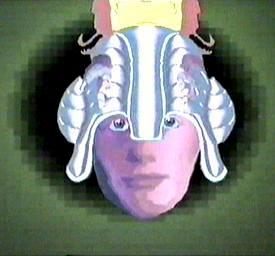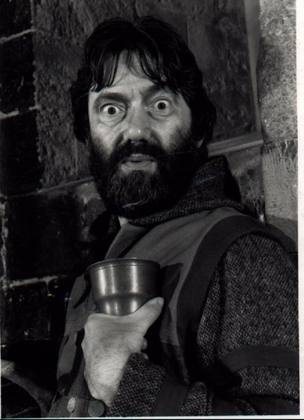|

The show featured teams of four children (around 11–16 years old). On the
call of "Enter, Stranger", the first member of the team (the "dungeoneer") would
enter Knightmare Castle via an antechamber belonging to Treguard of Dunshelm
After
giving his or her name, the dungeoneer would be asked by Treguard to call their
three advisors, who would magically appear next to the viewing apparatus beside
them (though, in Series 8, all members of the team appeared at once). Before
entering the dungeon, the dungeoneer would be given a knapsack to wear, in which they were to
place food found along the way, in order to replenish Life Force. In addition,
the "Helmet of Justice" was put on the dungeoneer's head, blocking their vision
except for the area immediately around them. The story was that this was to
protect the dungeoneer from seeing the real danger ahead.
The dungeoneer would then enter Treguard's partly computer-generated, partly
hand-drawn fantasy dungeon which was accomplished through bluescreen chromakey - hence
the need for the helmet, as the dungeoneer would otherwise just see a large blue
room. The team would watch the dungeoneer from a screen in the antechamber, and
guide the player using hurried descriptions and shouted instructions, overcoming
a variety of puzzles and traps in the dungeon. The instructions might be
"Sidestep left, walk forward, take a small step to your right, pick up the key",
much like many text-based computer games that relied on description and commands
rather than any visuals.
Spells could also be cast, which enabled the dungeoneer to attack, open
doors, restore one's life force, reveal clues and perform other special
abilities. This was made possible by literally spelling out the name of the
spell the team wished to cast. For example, to cast a WELL spell that revealed a
wellway to the next level, an advisor would call out: "Spellcasting: W-E-L-L".
It was also possible to reverse or stop a previously casted spell by dispelling,
which could be done by calling out "Dispell", followed by the letters of the
spell in an incorrect order, but not necessarily in reverse order. One team
(Team 7 of Series 2) was confounded by bad spelling, continually missing out the
letter O of a SHROUD spell while the antagonist Mogdred laughed evilly, while
Treguard, apparently constrained by magic, tried to tell them
("Let...ter...O!").
There were three levels in the dungeon. The object of the game was to collect
various items, meeting a selection of the many inhabitants of the dungeon along
the way, and get out 'alive'. There were different ways of travelling between
the levels, including wellways, mine cart rides, lifts ('descenders') and even airborne rides on
Smirkenorff, a dragon. The dungeon's
inhabitants included jesters, maids, and wizards, who would help the dungeoneer along
the way, and guards,
witches, and sorcerers, who
would either demand passwords,
spells, useful objects they need or simply try and kill the dungeoneer. Mary Whitehouse was
initially critical of this latter aspect of the programme (i.e. the simulated
fatal demise of the dungeoneers) after having been given a macabre description
of Knightmare by the press. However, she apologised after she saw
Knightmare for herself, noting that there was no gore and Treguard always
made it clear that the dungeoneers still survived in "their own time".
If the team managed to complete all three levels and master the dungeon, they
were awarded with a prize, which changed over the years from the "Silver Spurs
of Squiredom", to medallions, to "Frightknight" trophies (a design of a Knight holding a sword). Unlike most other children's
shows, Knightmare had no qualms over having a very high difficulty level.
In its eight-year history, only eight teams managed to successfully conquer the
dungeon: two in Series 2, one each in Series 4-6, two in Series 7, and a final
one in Series 8.
While the essence of Knightmare remained the same, there was also much
change and development throughout its series. In Series 2 (1988), a quest object
system was introduced, so that dungeoneers now had a specific item to reclaim at
the end. There were four main quest items: The Sword of Freedom (originally The Sword of Justice,
retrieved once), The Shield of Justice
(originally The Shield of Liberty, retrieved twice), The Cup that Heals (never
retrieved), and The Crowning Glory (retrieved three times). There
were occasionally others, such as "Free the Maid" (used twice, freed once) or
"Find the Talisman" (used once, retrieved once).
In its early series, Knightmare lacked a single major antagonist or
'baddie'. Indeed, originally Treguard was specifically a neutral character,
neither on the side of good nor evil. The closest there was to a main villain
was Mogdred (portrayed by John Woodnutt), but his main duty was, according
to Merlin (a wizard, and Mogdred's 'alter ego' in the first series) to "scare
you into making a mistake", though he did kill two dungeoneers, one in Series 2
and another early in Series 4. In Series 5 (1991), however, changes were made.
The majority of the characters were split into two sides: the righteous "Powers
that Be", and the villainous "Opposition", the leader of which was Lord Fear
played by Mark
Knight. By this time, Treguard's stance had now fully evolved into that of a
strictly good character.
Treguard, or Treguard of Dunshelm, was the dungeon master and was played by
Hugo Myatt for the entire length of the show's eight series. Information about
his supposed background can be found in the related literature (see merchandise
section). During the show, it was Treguard's job to assist the dungeoneer and
his/her team of helpers wherever possible.
At first, Treguard directed the contestants on his own. However from Series
4, Treguard had an assistant; Pickle the elf,
played by David
Learner and, from Series 7 after Pickle had "gone back to the forest",
Majida, a princess and genie of Arabian descent played by Jackie
Sawiris. (Majida originally claimed her name was "Daughter Of The Setting
Moon Whose Eyes Are Like Daggers In The Hearts Of Men Who Ride The Great Caravan
Of The Sultan".)
During the early series Treguard was portrayed as a neutral character, most
notably between Series 1 and 3. During the start of Episode 14 of Series 3 (when
no team had yet completed that series' dungeon) he went as far as to say "we're
celebrating an unbeaten record", apparently siding against the dungeoneers.
However, from Series 5 onwards there was a clear distinction made between 'The
Powers that Be' and 'The Opposition', against which Treguard became less neutral
and more inclined to actively aid and assist the dungeoneer to complete their
quest.
Over the course of the series Treguard became well known for his catchphrase
"Ooh, nasty!", regularly used just after a dungeoneer had died. Intended only as
a passing remark, this was originally an ad lib by Myatt. |
 Copyright(C) 2007
- 2020. All rights reserved. Copyright(C) 2007
- 2020. All rights reserved.
|

  

|

![]() Copyright(C) 2007
- 2020. All rights reserved.
Copyright(C) 2007
- 2020. All rights reserved. 
![]()
![]()
![]()
